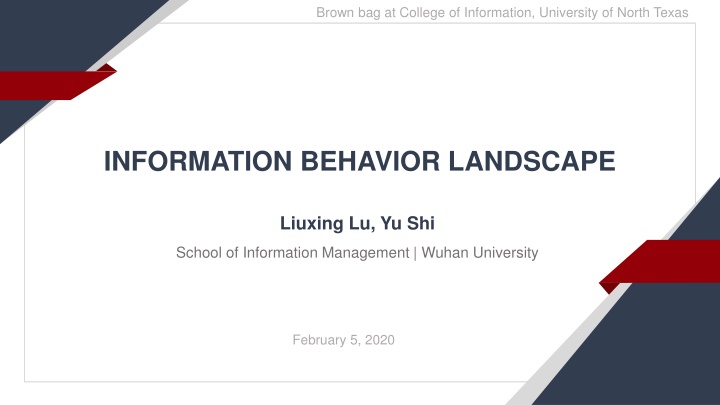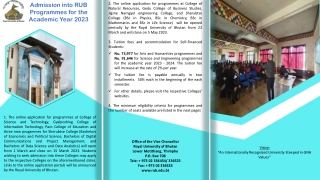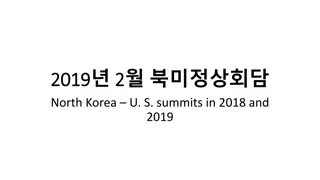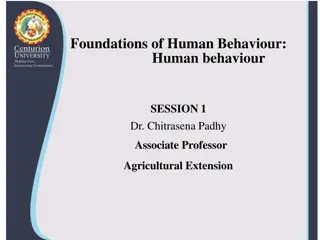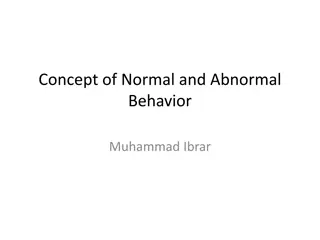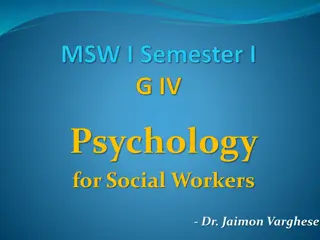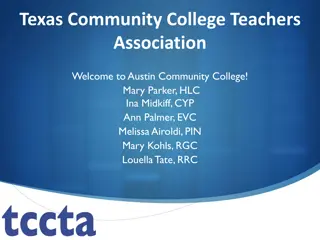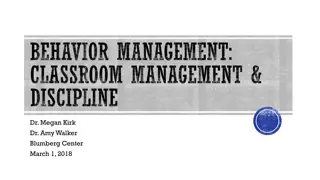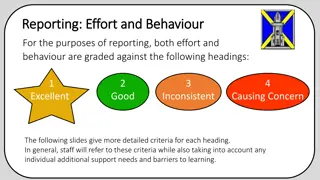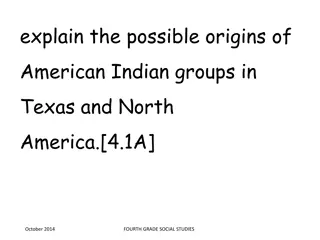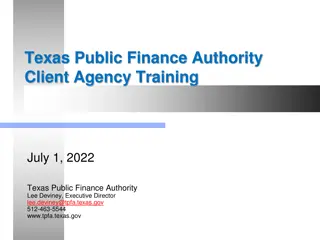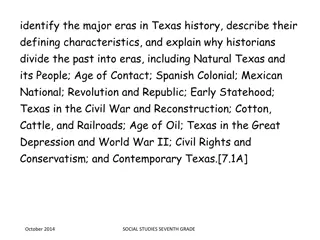Information Behavior Research Landscape at College of Information, University of North Texas
Explore the dynamic field of information behavior research at the College of Information, University of North Texas. Meet key figures like Dr. Ziming Zeng, Dr. Dan Wu, Liuxing Lu, Yu Shi, and learn about their fascinating work in areas such as recommender systems, data mining, and user cognition. Delve into hotspots, trends, theories, and methods shaping the future of information behavior studies.
Download Presentation

Please find below an Image/Link to download the presentation.
The content on the website is provided AS IS for your information and personal use only. It may not be sold, licensed, or shared on other websites without obtaining consent from the author.If you encounter any issues during the download, it is possible that the publisher has removed the file from their server.
You are allowed to download the files provided on this website for personal or commercial use, subject to the condition that they are used lawfully. All files are the property of their respective owners.
The content on the website is provided AS IS for your information and personal use only. It may not be sold, licensed, or shared on other websites without obtaining consent from the author.
E N D
Presentation Transcript
Brown bag at College of Information, University of North Texas INFORMATION BEHAVIOR LANDSCAPE Liuxing Lu, Yu Shi School of Information Management | Wuhan University February 5, 2020
About us 01 Overview for information behavior research 02
About us 01 A brief self-introduction
Yu Shi A PhD student from Wuhan University, China (Supervisor: Dr. Ziming Zeng) A visiting scholar at UNT (Supervisor: Dr. Junhua Ding) Major: Management Science and Engineering Research interest: information behavior, information recommendation (1) Information recommendation based on user cognition (2) User interest modeling.
Dr. Ziming Zeng A professor at the School of Information Management Research interests: recommender system, data mining, mobile visual search Published 5 books and over 100 papers on academic journals
Liuxing Lu A PhD student from Wuhan University, China (Supervisor: Dr. Dan Wu) A visiting scholar at UNT (Supervisor: Dr. Jiangping Chen) Major: Library Science Research interest: information behavior, information retrieval (1) Query reformulation in cross-device search. (2) Emotions change in pedestrian navigation while using map APP. (3) Factors that influence users mobile reading efficiency etc.
Dr. Dan Wu A professor at the School of Information Management, Wuhan University A Fulbright Scholar of University of North Carolina at Chapel Hill (2018) Secretary, ASIS&T Asia-Pacific Chapter General chair of the ACM/IEEE Joint Conference on Digital Libraries (JCDL) 2020 Research interests: information retrieval, information behavior, human- computer interaction, multilingual information processing and information organization Published 7 books and over 150 papers on academic journals
Overview for information behavior research 02 Hotspots, trends, theories, and methods
Information behavior The totality of human behavior in relation to sources and channels of information, including both active and passive information seeking, and information use. (Wilson, 2000) The term used to describe the many ways in which human beings interact with information, in particular, the ways in which people seek and utilize information. Focusing on the human relationship to information . (Bates, 2010) The totality of all the activities that take place while searching, seeking, encountering, (Spink and Cole, 2004) retrieving, processing, integrating, and using information.
Information behavior Wilson s model of information behavior (1981)
Information behavior Wilson s 1996 model of information behavior
Information behavior The term to describe individuals interact with (e.g. need, seek, give, and use ) information in different contexts (e.g. everyday living, schools, workplace). Involved people s cognitive, physical, and affective factors. (LIS) information interaction between users and systems (e.g. users find & use info, systems provide services based on users behavior)
Hotspots & research trends Information seeking behavior (ISB) children, senior, college students, librarians, immigration, doctors, engineers, homeless people, LGBTQ, etc. - mobile information seeking (multi-device search), collaborative information seeking, Learning health information seeking on websites. - the process and characteristics of ISB, the Contexts Living factors that influence ISB (devices, users Working emotions, tasks difficulties, etc.), information recommendation based on ISB
Theories & models/frameworks Library and information science - Wilson s models (Wilson, 1981; Wilson, 1996); Kuhlthau s model of the Information Search Process (ISP) (Kuhlthau, 1988); Berry-picking principle (Bates, 1989); Information foraging theory (Savolainen, 2017); Sense-making theory (Savolainen, 2014; Zhang et al., 2008) Psychology - Social cognitive theory (SCT)/Social learning theory (Jean et al., 2018; Moring, 2016); Theory of selective exposure (Dali, 2018); Appraisal theories (Savolainen, 2014); Expectancy-value theory (Savolainen, 2012)
Theories & models/frameworks Sociology - Practice theory (Gorichanaz, 2018); Others - [Education] Bruner s (1966) theory of instruction; - [Journalism, media studies and communication] Critical and cultural theory (Ocepek, 2018)
Methods Mix methods (qualitative + quantitative) Data collection methods - questionnaires, interviews - user experiments, think-aloud, eye-tracking, log collection, information world mapping, screen recording Data analysis methods - statistic analysis (descriptive, regression, etc.) - content analysis, text analysis
Hotspots & research trends Information Sharing Behavior Hotspots: Factors that influence information sharing behavior User; environment; technology User: motivation, personality traits (Liu et al., 2017; Kim et al., 2018); Environment: information sharing environment (community environment) (Chiu et al., 2011); Technology: information display (Nicoleta, 2017)
Hotspots & research trends Information Sharing Behavior Theories: social cognitive theory (Bandura, 1991); social capital theory(Chang,2011); social exchange theory(Liang,2008); social identity theory(Chung,2012); motivate theory(Hung,2011); justice theory(Chiu,2011); trust(Salehan,2018)
Hotspots & research trends Information Sharing Behavior Method: qualitative + quantitative questionnaire, semi-structured interviews, observations, think-aloud, document analysis, user experiment Trends: Relationship among various factors in information sharing behavior Utilizing multi-method approach to analyze sharing behavior
Hotspots & research trends The Application of Information Behavior in Recommendation Recommendations are created by using the user behavior (e.g. creating user portrait) User behavior can be collected implicitly and explicitly User behavior: rating, the number of clicked item and the sequence of the clicked items in the recommendation list, the duration of tracking, likes and dislikes and remarks on items
Hotspots & research trends The Application of Information Behavior in Recommendation Method: experimental method, network log analysis Trends: Learning recommender systems from user multi-behavior data. Identifying fine-grained interest of user.
References Savolainen, R. (2017). Heuristics elements of information-seeking strategies and tactics: a conceptual analysis. Journal of Documentation.73(6), 1322 1342. http://dx.doi.org/10.1108/JD-11-2016-0144 Asla, T. M., & Williamson, K. (2015). Unexplored territory: information behaviour in the fourth age. Information Research, 20(1), 158 169. Retrieved from http://InformationR.net/ir/20- 1/isic2/isic32.html Courtright, C. (2007). Context in information behavior research. Annual Review of Information Science and Technology, 41(1986), 273 306. https://doi.org/10.1002/aris.2007.1440410113 Dali, K. (2018). The lifeways we avoid: The role of information avoidance in discrimination against people with disabilities. Journal of Documentation, 74(6), 1258 1273. https://doi.org/10.1108/JD-04-2018-0057 Gorichanaz, T., Latham, K. F., & Wood, E. (2018). Lifeworld as unit of analysis. . Journal of Documentation, 74(4), 880 893. https://doi.org/10.1108/JD-12-2017-0174 Greyson, D., O Brien, H., & Shoveller, J. (2017). Information world mapping: A participatory arts-based elicitation method for information behavior interviews. Library and Information Science Research, 39(2), 149 157. https://doi.org/10.1016/j.lisr.2017.03.003 Ocepek, M. G. (2018). Bringing out the everyday in everyday information behavior. Journal of Documentation, 74(2), 398 411. https://doi.org/10.1108/JD-10-2016-0119
References Rousi, A. M., Savolainen, R., & Vakkari, P. (2016). A typology of music information for studies on information seeking. Journal of Documentation, 72(2), 265 276. https://doi.org/10.1108/JD-01- 2015-0018 Savolainen, R. (2012). Expectancy-value beliefs and information needs as motivators for task- based information seeking. Journal of Documentation, 68(4), 492 511. https://doi.org/10.1108/00220411211239075 Savolainen, R. (2014). Emotions as motivators for information seeking: A conceptual analysis. Library and Information Science Research, 36(1), 59 65. https://doi.org/10.1016/j.lisr.2013.10.004 St. Jean, B., Jindal, G., & Chan, K. (2018). You have to know your body! The role of the body in influencing the information behaviors of people with type 2 diabetes. Library Trends, 66(3), 289 314. https://doi.org/10.1353/lib.2018.0004 Wilson, T. D. (1999). Models in information behaviour research. Journal of documentation, 55(3), 249-270. Wilson, T. D. (2000). Human information behavior. Informing Science, 3(2), 49 55. https://doi.org/10.28945/576
References Liu, L., Cheung, C. M., & Lee, M. K. (2016). An empirical investigation of information sharing behavior on social commerce sites. International Journal of Information Management, 36(5), 686-699. Kim D H, Jang S C S. Online sharing behavior on social networking sites: Examining narcissism and gender effects[J]. International Journal of Hospitality Management, 2018, 68: 89-93. Chiu, C. M., Hsu, M. H., & Wang, E. T. (2006). Understanding knowledge sharing in virtual communities: An integration of social capital and social cognitive theories. Decision support systems, 42(3), 1872-1888. Nicoleta B l u & Sonja Utz (2017) Information sharing as strategic behaviour: the role of information display, social motivation and time pressure, Behaviour & Information Technology, 36:6, 589-605. Chang, H. H., & Chuang, S. S. (2011). Social capital and individual motivations on knowledge sharing: Participant involvement as a moderator. Information & management, 48(1), 9-18.
References Chung, N., Koo, C., & Park, S. B. (2012, March). Why people share information in social network sites? Integrating with uses and gratification and social identity theories. In Asian Conference on Intelligent Information and Database Systems(pp. 175-184). Springer, Berlin, Heidelberg. Liang, T. P., Liu, C. C., & Wu, C. H. (2008). Can social exchange theory explain individual knowledge-sharing behavior? A meta-analysis. ICIS 2008 proceedings, 171. Hung, S. Y., Durcikova, A., Lai, H. M., & Lin, W. M. (2011). The influence of intrinsic and extrinsic motivation on individuals' knowledge sharing behavior. International Journal of Human-Computer Studies, 69(6), 415- 427. Jawaheer, G., Weller, P., & Kostkova, P. (2014). Modeling user preferences in recommender systems: A classification framework for explicit and implicit user feedback. ACM Transactions on Interactive Intelligent Systems (TiiS), 4(2), 1-26. Akcayol, M. A., Utku, A., Aydo an, E., & Mutlu, B. (2018). A weighted multi-attribute-based recommender system using extended user behavior analysis. Electronic Commerce Research and Applications, 28, 86-93.
Brown bag at College of Information, University of North Texas Thank you Liuxing Lu (liuxing.lu@unt.edu) Yu Shi (yu.shi2@unt.edu)
